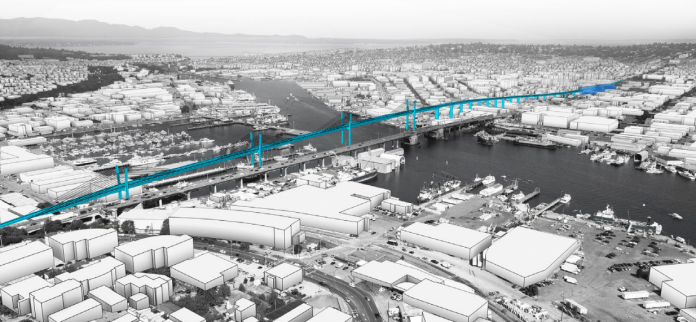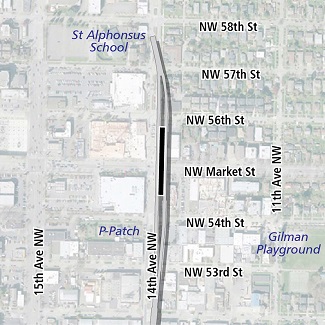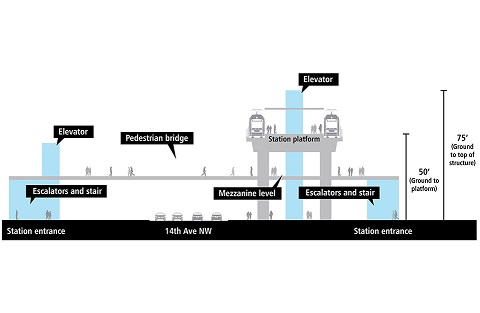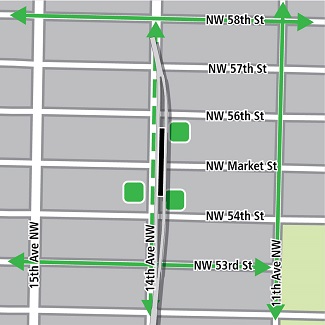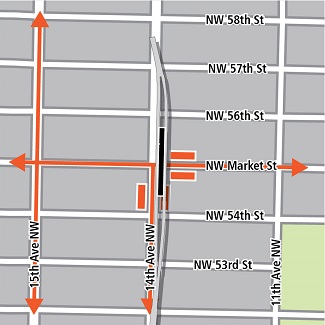Ahead of their mid-2021 release and comment period of the West Seattle and Ballard Link Extensions’ Draft Environmental Impact Statement (EIS), Sound Transit has updated their open house page. In preparation of the comment period, the transit agency provides new details on the environmental review process, alternatives being studied in the Draft EIS, and potential station details and transportation contexts.
Immediately, a delay in the extensions’ environmental review process stands out as an important development in the updated website. Previously reported late 2020 and 2022 releases for the draft and final EIS have respectively been shifted to the mentioned mid-2022 and 2023. The delay in environmental review is also reflected in a delayed completion date of the extensions to 2031 for West Seattle and 2036 for Ballard from 2030 and 2035.
New Station Details
Going out of order, details on stations and their contexts are where the open house introduces most of its new information. Initially explored are concepts for elevated stations, and context outlined for existing and potential pedestrian, bike, and bus infrastructure–a priority highlighted in gathered feedback–for all of the stations. The agency constructed a website that allows readers to compare station alternatives and their transportation infrastructure for each station alternative to be reviewed in the draft EIS.
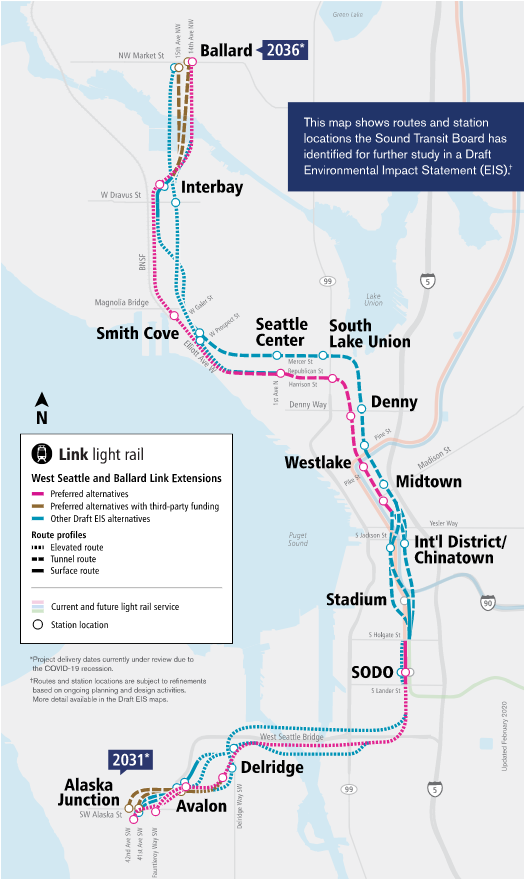
For example, visitors can flip through the illustrations of the elevated 14th Avenue NW station preferred by Sound Transit for a Ballard station. The station’s gallery of images gives the visitor an idea of conceptual and existing transportation infrastructure. Below that slideshow are galleries of the other three Ballard alternatives. Elevated station concepts for Ballard all have access to both sides of either 14th Avenue NW or 15th Avenue NW with pedestrian bridge and mezzanine level access. Like some existing stations, bike storage and new bike routes would be built out.
These initial concepts are based on the feedback from the online open house held in the fall of 2019. While each future station’s surrounding community had their own sets of popular values, walkability and accessibility was an uniting thread for the vast majority of the communities. This shows up in the sheer number of mezzanines and pedestrian bridges that appear in the initial concepts.
More information on stations and their initial station planning concepts will be shared when the Draft EIS is published.
Mulling over the alignment alternatives again
Jumping back to the alternatives, Sound Transit gives us visuals for Motion No. M2019-51, which designated alternatives for the Draft EIS to include, and Motion No. M2019-104, which added more alternatives based on community feedback and political pressure. The agency’s board approved preferred alternatives, alternatives that require third-party funding, and other alternatives for the Draft EIS to include. Sound Transit has divided the extensions into five sections, West Seattle, SoDo, Chinatown/International District, Downtown, and Interbay/Ballard.
Most represented alternatives have already been whittled down to two to four options for each section of the extension. Standing out is Avalon that branches into a chaotic five to seven alignments to the Alaska Junction station. Motion M2019-104 introduced a few of those alignments when it officially added the elevated Andover Street station as a Delridge alternative, which added two more alignment options that had downstream effects for Avalon/Alaska Junction. Note that the preferred options are all elevated, and all other options require tunneling and additional third-party funding at some point.
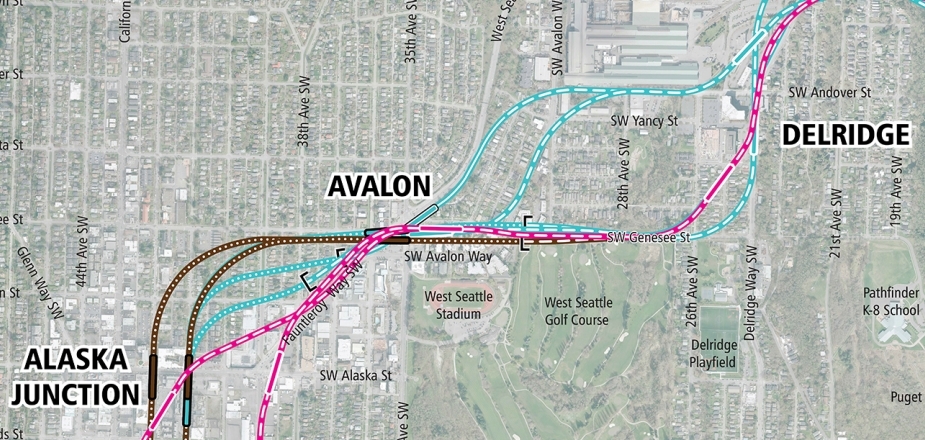
Moving northward, we pass the Duwamish crossing–whose elevated crossing got recently some attention when Mayor Durkan suggested multimodal options for it–and encounter a refined mixed-profile station alternative for SoDo that elevates the alignment of the West Seattle Extension line earlier than other options. This option is the only other update in M2019-104. It elevates a new SoDo station, retains the existing SoDo Station at-grade and Lander Street at-grade, and constructs a new Holgate Street overcrossing.

From Chinatown-International District to Ballard there is no change since Stephen Fesler described the alternatives in The Urbanist. For Chinatown, a new alignment will either be just east or just west of the existing line. Downtown alternatives are either a tunnel along 5th Avenue and then west on Harrison Street and Republican Street, or a tunnel along 6th Avenue and then west on Mercer Street. Interbay/Ballard is a choice of west or east of Interbay Golf Center, and then 14th Avenue NW or 15th Avenue NW in Ballard with or without a tunnel.
Note that absent from any Draft EIS updates is a 20th Avenue NW tunnel station option for Ballard that had just been designated for study and not inclusion for the draft, so far. It’s been over a year since more alternatives were added to the Draft EIS, so we might be stuck with a station on 14th or 15th Avenue. It’s unfortunate that a Ballard station could be so off-center from the neighborhood’s established density, and relatively poor on accessibility for many in Ballard, but locating it on 14th Avenue NW or 15th Avenue NW could provide impetus to upzone some of the single-family zones in the eastern part of Ballard. Plus, an elevated station, particularly on 15th Avenue NW, would be primed for northward extension in the future and at less expense.
A long road toward construction
The open house ends with a note on staying engaged. It offers opportunity to get project news, announcements, and public involvement opportunities to your email, urges visitors to share the information, and links video resources on the project. There is even space to comment on ways that the agency can engage the reader, request a virtual briefing for a group, or email or speak with an outreach specialist by phone.
With the delay from Covid-19 impacts, Sound Transit is now targeted mid-2021 for publication of the Draft EIS, with a final EIS expected to be published in 2023. The extensions are still very early in their timelines and Covid and recession could continue to bog down the process. More discussion on potential delays will come in 2021’s realignment talks between the Board, setting up Seattle’s light rail infrastructure for potentially major effects, as the 130th Street station’s opening will also be decided then.
The next comment period will come with the Draft EIS. Stay involved, as it is of utmost importance to get the West Seattle and Ballard extensions done right. To reiterate past articles, the Ballard and Alaska Junction stations are just temporary end points right now. Sound Transit is planning them for forward compatibility, so we need to get the most out of these stations to give future expansion the best connections possible.
Shaun Kuo is a junior editor at The Urbanist and a recent graduate from the UW Tacoma Master of Arts in Community Planning. He is a urban planner at the Puget Sound Regional Council and a Seattle native that has lived in Wallingford, Northgate, and Lake Forest Park. He enjoys exploring the city by bus and foot.


